Blue John Cavern
Useful Information
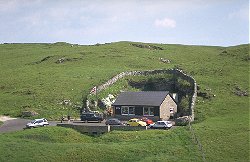
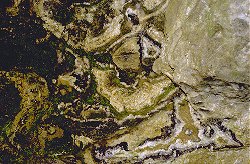
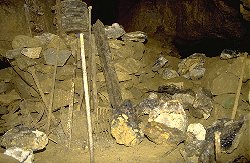
| Location: |
At the top of the Winnats Pass, a few kilometers west of Castleton, Peak District.
25 km from Sheffield, 45 km from Manchester.
Bus to cave from Castleton free car park. The Mam Tor road is closed to traffic. From Castleton, go via Winnats Pass. (53.345565, -1.803479) |
| Open: |
Summer daily 9:30-17:30. Winter daily 9:30 to dusk. First tour 10:15, last tour 30 min before closing. Closed 25-DEC, 01-JAN, Boxing Day. [2021] |
| Fee: |
Adults GBP 15, Children (5-15) GBP 10, Children (0-4) free, Family (2+2) GBP 45, Seniors GBP 11, Students GBP 11. [2021] |
| Classification: |
 Karst Cave. Karst Cave.
 Gem Mine. Gem Mine.
|
| Light: |
 Electric Light Electric Light
|
| Dimension: | L=1,600 m, T=11 °C. |
| Guided tours: | L=560 m, Depth=65 m, D=60 min, St=490. Not suitable for people with heart conditions, bronchial illness or babes in arms. |
| Photography: | |
| Accessibility: | |
| Bibliography: |
Arthur E. Ollerenshaw:
Blue John Cavern and Blue John Mine, Castleton via Sheffield.
|
| Address: |
Blue John Cavern, Mam Tor, Castleton, Hope Valley, S33 8WP England, Tel: +44-1433-620638.
E-mail: The Original Blue John Craft Shop, Cross Street, Castleton, Hope Valley, S33 8WP England, Tel: +44-1433-620642. E-mail: |
| As far as we know this information was accurate when it was published (see years in brackets), but may have changed since then. Please check rates and details directly with the companies in question if you need more recent info. |
|
History
| ~50 | the Romans discovered Blue John and manufactured vases and cups. |
| ~1700 | local miners discovered Blue John Cavern while following the Blue John Vein. |
| 1802 | described by the eminent mineralogist John Mawe, Esq., in his work The Mineralogy of Derbyshire. |
| 1884 | The Original Blue John Craft Shop established. |
| 1919 | Blue John Cavern acquired by the Ollerenshaw familiy. |
Description
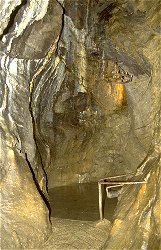
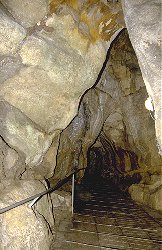
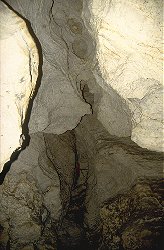
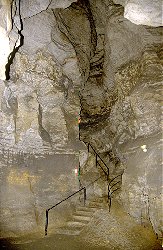
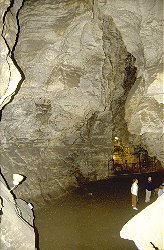
Blue John Cavern is a natural cave with some mine workings. Blue John is a unique fluorspar or fluorite, found only at Castleton, which makes it the rarest natural formation in the British Isles. The mineral is found in veins in the limestone, 8 of the 14 known veins are located at Blue John Cavern. Such veins are typically only 10 cm to 20 cm thick, which was restricting the size of the objects which could be created from the mineral. However, here were some nodular concretions lining the inner walls of cavities. While the crystals of Fluorite are cubic, the bands contain mostly elongated crystals radiating from a central focal point. So they form concentric bands of blue, purple, white, and yellow bands. Uncommon for fluorite is also that Blue John sometimes shows fluorescence, if it is exposed to ultra-violet light.
The Romans were the first to discover Blue John some 2,000 years ago. However, there are no documents from this time, so we actually know only the products which were created from the rock, if they survived. Two Blue John vases were unearthed during excavations of Pompeii, so they were not only of local fame, but they were exported to Italy before 79.
It seems mining was discontinued for a long time, after the Romans left Britain. But in the 18th century there was obviously a revival. All around Castleton miners were looking for various resources, mostly for lead ore. But he also mined Blue John. The Odin Vein is a rather important lead ore vein which was massively mined, and it is clearly visible right in front of the modern day show cave. The pits are abandoned open cast mines. It seems some miners were looking for other veins in the area and found a daylight shaft, the entrance to a cave. After entering the cave they discovered the Blue John veins on the cave walls, which were easily accessible.
In those early days mining was done by hand, with chisel and hammer. The mining of Blue John required a lot of care, as the stress could break the brittle crystals and the material would break during processing. Nodules were dislodged with hammer, chisel and crowbars. The veins require more work, a deep ledge was cut into the limestone above the entire deposit. Then the ledge was extended downwards on both sides, left and right until the net bedding plane was reached. With the bedding plane, the block was now cut off on four sides, it was only connected at the rear. The final phase was called "lifting", when the entire piece was lifted with wedges and crowbars. The rear end brok off, and the whole block was pulled out. Now the excess material was remove on all sides. Actually this was the first time the miners learned the size of the find. It was luck and experience to find the best Blue John and extract it unbroken.
There are numerous legends how the rock was named Blue John. Very likely the name was made up by John Kirk and Joseph Hall who worked the mines in the 18th century.
The Blue John is mined until today. During the winter months the cave guides do the necessary maintenance, but they also do some mining. Craftsmen at a workshop in Castleton create jewellery and handcrafted items from the mineral. The items are sold in the souvenir shop at the cave entrance, in the Original Blue John Craft Shop in Castleton, and online in the webshop.
The path of the tour follows the dried up bed of the river that formed this cave. The river existed only for short periods during the ice age, it was fed by the melting ice of the beginning interglacials. Last time the river was running is more than 8,000 years ago.
A mined passage descends steeply from the entrance into the natural caverns, and visitors can soon see the original vein of Blue John which the miners were following when they burst into the caves.
Of course the miners did not have a comfortable passage to walk down into the caves, and it is possible to see the original entrance, a shaft high in the roof. The first explorers were lowered on a rope into the caves down this aven.
The action of water is visible everywhere in the cavern in the scalloping and etching of the rock walls. Soon the path follows the dried-up river bed itself.
We are able to see relics of the old miners - a trolley, windlass and bellows, and some of the old workings where the best pieces of Blue John were obtained. These were used to make such things as vases, some of which were given to the Duke of Devonshire and the Pope, and can now be found in Chatsworth House and the Vatican.
The sheer beauty of the caverns, such as the Crystallised Cavern with its lofty, dome-shaped roof, exotic mineral colourings and beautiful crystals, has to be seen to be believed. Indeed, the whole of the show section winds through many chambers, each one special and exciting, with wonderful formations and colourings.
Finally, the Variegated Cavern is reached. Here it is possible to appreciate the force and power of the water which formed the caverns. Standing on a platform 20 feet above the floor, it is possible to look on into the blackness, down a vast hall, where only speleologists tread, littered with huge boulders, carried there by some long forgotten stream.
It is not until one begins the trip back to the surface along the same route taken down the cave that one appreciates the depth one has descended. This cave descends for 214 feet, but the effort of reclimbing this distance back to the surface is relieved by the beauty of the caverns which are passed on the way.
Text from: Tony and Anne Oldham (1972): Discovering Caves - A guide to the Show Caves of Britain. With kind permission by Tony Oldham.
- See also
 Search DuckDuckGo for "Blue John Cavern & Mine"
Search DuckDuckGo for "Blue John Cavern & Mine" Google Earth Placemark
Google Earth Placemark Blue John Cavern - Wikipedia (visited: 24-SEP-2010)
Blue John Cavern - Wikipedia (visited: 24-SEP-2010) Blue John Cavern & Mine, official website.
Blue John Cavern & Mine, official website. Blue John Mine (visited: 24-SEP-2010)
Blue John Mine (visited: 24-SEP-2010) Blue John Mine and Cavern, Castleton , Hope Valley, England (visited: 24-SEP-2010)
Blue John Mine and Cavern, Castleton , Hope Valley, England (visited: 24-SEP-2010) Blue John Cavern - Atlas Obscura (visited: 13-JUL-2023)
Blue John Cavern - Atlas Obscura (visited: 13-JUL-2023)
 Index
Index Topics
Topics Hierarchical
Hierarchical Countries
Countries Maps
Maps